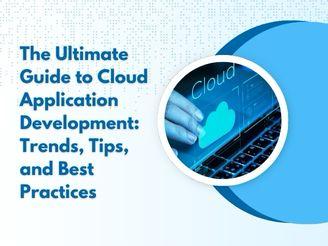
Cloud applications have become the new industry standard. Every software rollout is happening in the cloud. With benefits like flexibility, cost-efficiency, and real-time updates, cloud-based platforms are powering everything from productivity tools to complex enterprise systems.
A Cloud Security Alliance report reveals that 98% of companies worldwide use cloud services, in one form or another, such as SaaS applications or complete cloud-native networks. However, give the freedom, cost-effectiveness, and flexibility the cloud computing technology provides to businesses, it is necessary to transform to gain a competitive edge.
Enterprises are aggressively investing in adopting a cloud-first strategy, where the team prioritizes the use of cloud-based services over on-premise IT solutions. Cloud application development services help in building apps that are scalable, resilient, and easily accessible from anywhere.
These services enable faster deployment, seamless integration with other cloud tools, and reduced infrastructure costs. Let’s understand more about cloud application development.
What is Cloud Application Development?
When you build an app that runs online instead of on a local machine, that’s cloud development. These apps reside in cloud environments like AWS, Azure, Google Cloud, or any other cloud service.
Standard applications need local servers or individual devices for installation while they depend heavily on traditional on-premise infrastructure. Businesses had to invest in hardware, data centres, and in-house IT teams to manage, update, and maintain the deployed applications.
This increased the operational cost and burden. However, cloud computing removes all the hurdles, as the cloud-based applications are hosted on remote servers and accessed through the internet, eliminating the need for physical infrastructure. Here’s how cloud applications transform enterprise operations:
- Flexibility: Businesses can scale the resources up and down to fit their needs. Cloud services can be accessed and customized from anywhere through the Internet.
- Efficiency: With cloud application development services, applications can be deployed quickly, eliminating worries about underlying infrastructure costs and maintenance.
- Strategic Value: Cloud applications give businesses a competitive edge to respond dynamically to the market needs.
Top Trends in Cloud Application Development
The cloud computing technology has never stopped evolving. New ideas and innovations are always changing how developers build, manage, and deliver applications. Here are some emerging trends in the cloud computing:
1. Serverless
Serverless computing methods revolutionize the entire process of developing and deploying code applications. After uploading your functions to the cloud platform, they will operate autonomously. You need not deal with infrastructure management or server thoughts or scalability concerns.
This is cost-effective because you only pay when your code is running. And it lets you move faster. Many companies use custom application development services where the applications are built entirely on serverless architecture for speed and flexibility.
2. Multi-Cloud
Businesses are no longer relying on just one cloud service provider. Multi-cloud spreads risk and performance. If one provider goes down, another keeps your app running.
Using multiple platforms also lets you pick the best of each. Some cloud tools are better suited for data storage, while others are better for AI or analytics. Multi-cloud gives you the best of all.
3. AI and Smart Features
AI is no longer just a buzzword. Cloud platforms now have powerful AI and machine learning tools you can use today. You can analyse user behaviour, predict trends, and offer personalized content or recommendations.
Adding AI to your app no longer requires a team of data scientists. With custom app development services, you can integrate AI models from your cloud provider and add smart features in minutes.
4. Edge Computing
Edge computing brings processing power to the user. You can understand user actions to forecast market patterns so you can create individualized content suggestions. This reduces lag and improves performance, especially for real-time features like video or gaming.
It’s a big trend for apps that require low latency and high speed. Combined with cloud application development services, edge computing makes your app feel fast no matter where your users are.
5. Low-Code and No-Code
Low-code and no-code platforms make development accessible to more people. Visual tools enable developers to create applications without writing code. These platforms speed up delivery, especially for internal apps or MVPs.
Developers still play a big role, but these tools reduce the time spent on routine tasks. With the right custom app development services, you can blend low-code speed with high-code precision for the best results.
Tips to Build a Great Cloud App
Building a cloud app takes planning, knowledge, and the right decisions at every step. These tips will help you avoid the common pitfalls and get better results.
Step 1. Conduct Market and Requirement Analysis
Understand your market for cloud application deployment. What are the target audience’s needs, what is the gap that existing solutions fail to bridge, why do you want to deploy an application, and other questions like that? These questions will help you determine the purpose of deploying an application and ensure you don’t get lost along the way.
Step 2. Choose a Method of Development
Custom application development is no longer restricted to hiring an in-house IT team or outsourcing it to a capable vendor. There are different methods available, such as:
- Hire an in-house IT team
- Find expert and experienced freelancers to do your work
- Outsource the development to a reliable third-party development company, like Rainstream Technologies As per your development needs and budget, you need to select the best approach. Collaborating with a reliable technical partner is a better option as it offers a balanced mix of expertise, scalability, and long-term support. Unlike others, building an in-house team can be expensive, and working with freelancers is unreliable and requires too much effort from your end.
Step 3. Product Development and Testing
Once you have selected your development approach, here’s how the cloud application development service proceeds.
- Decide on the cloud platform, whether AWS, Google Cloud, or Azure, based on your app’s scalability, storage, security, and integration needs.
- Select the type of deployment, like hybrid, public, private, or multi-cloud.
- The development team works on the app’s architecture, which includes microservice architecture, API integration planning, and database design.
- Developers build the app’s frontend (user interface) and backend (server-side logic, databases, APIs). Prototypes and wireframes will be created first, then the application development will begin.
- Cloud-based services, like storage, databases, authentication, and monitoring and logging, are integrated.
- The application is rigorously tested using automated and manual approaches.
Step 4. Deployment and Monitoring
The custom application is deployed to the cloud using CI/CD pipelines for automated builds and rollouts. Platforms like GitHub Actions, Jenkins, or Azure DevOps help streamline deployment with minimal downtime.
After launch, continuous monitoring of app performance, uptime, and user behaviour is crucial.The system receives routine updates alongside security fixes and feature updates as required.
Best Practices that Experts Follow For Custom Cloud Application Development
Let’s understand the best practices that experts consistently follow when developing custom cloud applications:
1. Break Your App into Small Parts
This is called microservices architecture. Instead of one big app, you have smaller services that do specific jobs. These systems maintain constant communication but function as separate units.
The architecture is preferred because it is easier to fix bugs, roll out updates and test changes. If one service fails, others keep working. Many cloud app development services recommend this model for long-term success.
2. Monitor Everything
Monitoring teams use real-time monitoring tools to check your app’s health, performance and traffic. With the set alerts, the team is notified when something needs quick attention.
Cloud platforms have built-in tools to make this easy. With proper monitoring, the team can quickly fix issues and minimize downtime.
3. Use Automation
Automate what you can. Tests, deployments, and updates all benefit from automation. It saves time, reduces errors, and makes your team more productive. You can also automate scaling, cost tracking, and alerts. Automation tools are included in most cloud platforms, and your development team can set them up for you.
4. Keep Costs in Check
While the cloud offers great flexibility, costs can quickly escalate if not monitored properly. Monitoring teams regularly review usage, turn off unused services, and optimize storage, database queries, and computing resources.
Final Thoughts
You don’t need to be a tech expert to build a powerful app. With the right tools and the right team, you can create something that works beautifully and grows with you.
Cloud application development services give you the power to launch faster and scale smarter. And with custom app development services, your app can match your exact vision. For instance, if you have an application idea and you need a partner who can quickly convert your idea into an MVP, then Rainstream Technologies experts can help you. Reach out to our experts today.




